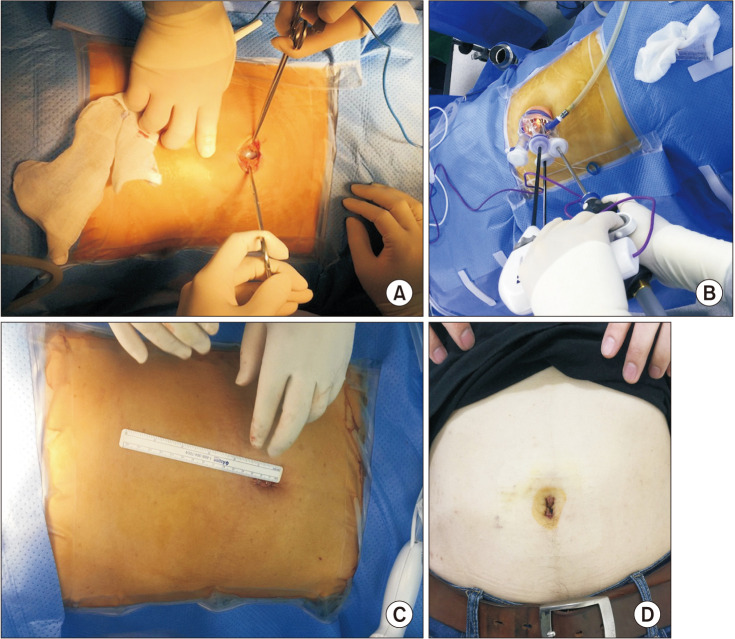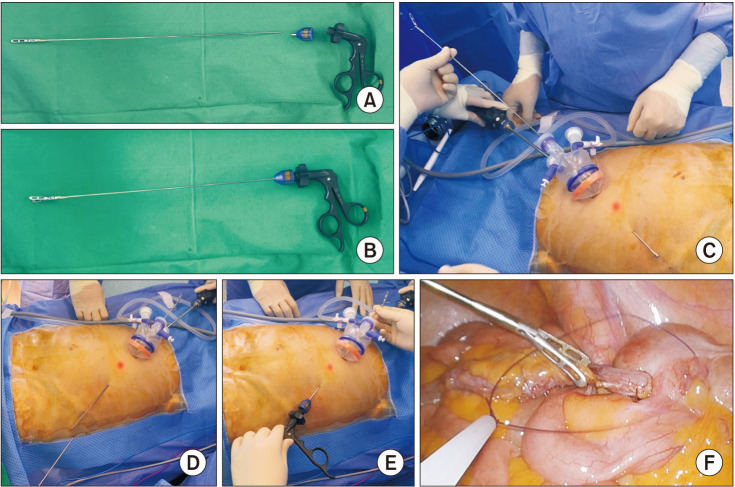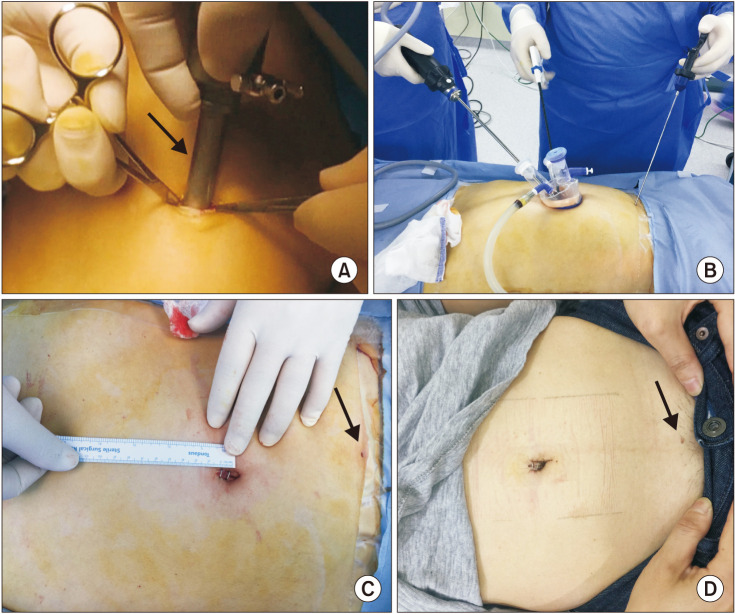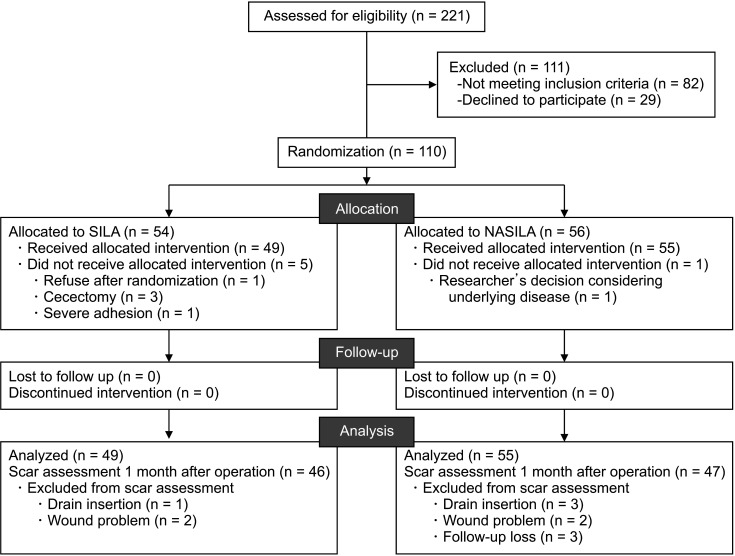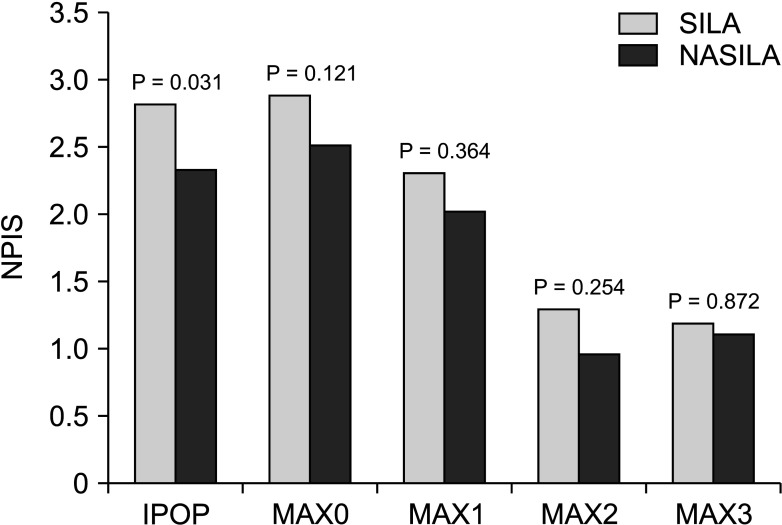Ann Surg Treat Res.
2021 Dec;101(6):350-359. 10.4174/astr.2021.101.6.350.
Comparison of postoperative pain after needle grasperassisted single-incision laparoscopic appendectomy versus single-incision laparoscopic appendectomy: a prospective randomized controlled trial (PANASILA trial)
- Affiliations
-
- 1Department of Surgery, Chung-Ang University Hospital, Chung-Ang University College of Medicine, Seoul, Korea
- KMID: 2522933
- DOI: http://doi.org/10.4174/astr.2021.101.6.350
Abstract
- Purpose
This study was performed to compare the efficacies of newly developed needle grasper-assisted (Endo Relief) single-incision laparoscopic appendectomy (NASILA) and single-incision laparoscopic appendectomy (SILA).
Methods
This study enrolled 110 patients with acute appendicitis without periappendiceal abscess, diagnosed using computed tomography, who were randomized to the SILA (n = 54) and NASILA groups (n = 56) between December 2017 and August 2018 (6 patients withdrawn). The NASILA technique entailed a small umbilical incision for the glove port (equivalent to that for a 12-mm trocar), and a 2.5-mm suprapubic incision for the needle grasper.
Results
The SILA and NASILA groups included 49 (male, 61.2%) and 55 (male, 54.5%) patients, respectively. Age, body mass index, abdominal surgical history, symptom duration, and use of patient-controlled analgesia did not differ significantly between the 2 groups. The main wound size was significantly smaller in the NASILA group than in the SILA group (1.8 ± 0.4 cm vs. 2.2 ± 0.4 cm, P < 0.001). The operative time and estimated blood loss did not differ significantly between both groups. The immediate postoperative pain score, i.e., the primary endpoint, was significantly lower in the NASILA group than in the SILA group (2.33 ± 0.98 vs. 2.82 ± 1.29, P = 0.031). The complaints for scar status 1 month postoperatively did not differ significantly between the groups.
Conclusion
NASILA could attenuate postoperative pain by minimizing the size of the surgical wound; further, NASILA may not be inferior to SILA in terms of cosmetic results.
Figure
Reference
-
1. Körner H, Söndenaa K, Söreide JA, Andersen E, Nysted A, Lende TH, et al. Incidence of acute nonperforated and perforated appendicitis: age-specific and sex-specific analysis. World J Surg. 1997; 21:313–317. PMID: 9015177.
Article3. Pelosi MA, Pelosi MA 3rd. Laparoscopic appendectomy using a single umbilical puncture (minilaparoscopy). J Reprod Med. 1992; 37:588–594. PMID: 1387906.4. Park JH, Hyun KH, Park CH, Choi SY, Choi WH, Kim DJ, et al. Laparoscopic vs transumbilical single-port laparoscopic appendectomy: results of prospective randomized trial. J Korean Surg Soc. 2010; 78:213–218.
Article5. Carter JT, Kaplan JA, Nguyen JN, Lin MY, Rogers SJ, Harris HW. A prospective, randomized controlled trial of single-incision laparoscopic vs conventional 3-port laparoscopic appendectomy for treatment of acute appendicitis. J Am Coll Surg. 2014; 218:950–959. PMID: 24684867.6. Villalobos Mori R, Escoll Rufino J, Herrerías González F, Mias Carballal MC, Escartin Arias A, Olsina Kissler JJ. Prospective, randomized comparative study between single-port laparoscopic appendectomy and convent ional laparoscopic appendectomy. Cir Esp. 2014; 92:472–477. PMID: 24581876.7. Teoh AY, Chiu PW, Wong TC, Poon MC, Wong SK, Leong HT, et al. A double-blinded randomized controlled trial of laparoendoscopic single-site access versus conventional 3-port appendectomy. Ann Surg. 2012; 256:909–914. PMID: 23154391.
Article8. Deng L, Xiong J, Xia Q. Single-incision versus conventional three-incision laparoscopic appendectomy: a meta-analysis of randomized controlled trials. J Evid Based Med. 2017; 10:196–206. PMID: 28276643.
Article9. Choi GJ, Kang H, Kim BG, Choi YS, Kim JY, Lee S. Pain after single-incision versus conventional laparoscopic appendectomy: a propensity-matched analysis. J Surg Res. 2017; 212:122–129. PMID: 28550898.
Article10. Kim BJ, Kim JW, Choi YS, Park YG, Kim BG, Park JM, et al. Minimization of wound with the assistance of a needle grasper in single-incision laparoscopic appendectomy. Surg Innov. 2019; 26:536–544. PMID: 31132924.
Article11. Frutos MD, Abrisqueta J, Lujan J, Abellan I, Parrilla P. Randomized prospective study to compare laparoscopic appendectomy versus umbilical single-incision appendectomy. Ann Surg. 2013; 257:413–418. PMID: 23386239.
Article12. Li X, Zhang J, Sang L, Zhang W, Chu Z, Li X, et al. Laparoscopic versus conventional appendectomy: a meta-analysis of randomized controlled trials. BMC Gastroenterol. 2010; 10:129. PMID: 21047410.
Article13. Kang BM, Choi SI, Kim BS, Lee SH. Single-port laparoscopic surgery in uncomplicated acute appendicitis: a randomized controlled trial. Surg Endosc. 2018; 32:3131–3137. PMID: 29340826.
Article
- Full Text Links
- Actions
-
Cited
- CITED
-
- Close
- Share
- Similar articles
-
- Solo Single-Incision Laparoscopic Appendectomy versus Conventional Single-Incision Laparoscopic Appendectomy
- Laparoscopic Appendectomy with a Single Incision in a Single Institute
- The Initial Experience with a Single Incision Laparoscopic Appendectomy
- Single-incision Laparoscopic Surgery for Simultaneous Appendectomy and Cholecystectomy
- Surgical Outcomes of Single-port Laparoscopic Appendectomy versus Conventional Laparoscopic Appendectomy in Children: Preliminary Report of a Prospective Randomized Trial

